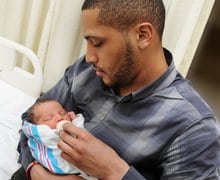Moms more likely to make decision about the cut
Parents have gone back and forth on whether to circumcise their baby boys over the last three decades. Circumcision of newborn boys at U.S. hospitals dropped 10 percent from 1979 to 2010, according to a report released last week by the CDC’s National Center for Health Statistics.
The national rate dropped from 65 percent to 58 percent, with highs and lows that dipped to 55 percent in 2007.
“We don’t have information about the cause,” says Maria Owings, Ph.D. “We’re just reporting the actual national and regional rate for that period.” Owings collaborated on the report with Sayeedha Uddin, M.D., and Sonia Williams.
The researchers noted that the fluctuations coincided with changes in recommendations from the American Academy of Pediatrics.
During the 1970s, AAP task force reports said that routine circumcisions of newborns weren’t medically necessary. In a 1989 reversal, the AAP said the procedure provided some medical benefits. Despite these benefits, the organization issued a policy statement a decade later, saying insufficient evidence prevented it from recommending routine circumcisions.
Chiledum A. Ahaghotu, M.D., chief of urology at Howard University Hospital, isn’t surprised by the decline and fluctuations based on AAP decisions and health insurance changes. “The figures weren’t surprising if you look at the policies and economics of circumcision over the last couple of decades,” Dr. Ahaghotu says.
“Most payers began bundling newborn circumcision into perinatal services, and when that happened the neonatologists and the nursery pediatricians were not able to reliably bill for the service,” he explains. “That’s when you started to see a trend of babies not getting circumcised. In the ’50s and ’60s, there was a widespread belief that circumcision was beneficial for hygiene and good health.”
In addition to hygienic benefits, circumcision has been linked to lower rates of sexually transmitted infections among older males and their partners.
Studies indicate that circumcision rates for black babies are slightly lower, but the difference isn’t statistically significant. Some of the variation could be linked to the country of origin. For example, rates are low for Caribbean islands such as Jamaica, but higher for Muslim areas and ethnic groups in Africa.
“When you look on the African continent, it’s going to vary dramatically based on culture and relation,” says Dr. Ahaghotu, who is of Nigerian descent.
Dr. Ahaghotu was principal investigator of a study published in the Journal of the National Medical Association in April 2009 that looked at African-American parents in the United States.
“The majority of participants still felt strongly about having their child circumcised,” he says. Ninety-six percent of respondents said the procedure was healthy. Mothers were 12 times more likely than fathers to make the final decision. The study found higher rates among single mothers than among single fathers and couples.
The CDC study also found regional variations. Circumcision rates were fairly consistent in the Northeast, mirrored national fluctuations in the Midwest, rose and then dropped in the South, and were lowest in the West.
For more about circumcision, go to theGrio.com.






